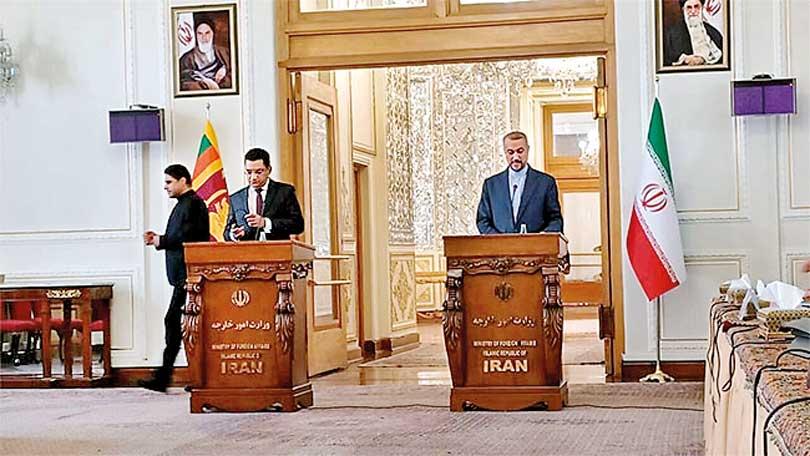
Sri Lankan Foreign Minister Ali Sabry and Iranian Foreign Minister Hossein Amir Abdollahian in Tehran
 As part of its bid to bolster ties with the West Asian region (the middle-east), Sri Lanka has turned its attention towards Iran, seeking to deepen economic ties which, otherwise, remained neutral in recent years after the US sanctions slapped on that country.
As part of its bid to bolster ties with the West Asian region (the middle-east), Sri Lanka has turned its attention towards Iran, seeking to deepen economic ties which, otherwise, remained neutral in recent years after the US sanctions slapped on that country. The stage for it has now been set as Foreign Minister Ali Sabry recently concluded a bilateral visit to Tehran. The focal point of these deliberations remained the growth of economic relations between the two nations.
Sri Lanka’s interest in furthering these relations is notably underpinned by the fact that Iran stands as a significant market for Sri Lanka’s renowned tea products. Given Sri Lanka’s quest for foreign exchange to bolster its economic standing, the nation is sparing no effort to explore avenues that could secure its export interests.
However, a formidable obstacle looms large in the form of prevailing U.S. sanctions on Iran, which have cast a shadow on trading activities. Notably, Sri Lanka remained ensnared in a complex process to repatriate US $250 million, pertaining to erstwhile fuel transactions. At one point in the past, Iran used to import tea valued at US $ 300 million from the world and Sri Lanka catered to half of it. Following the US sanctions, bilateral trading in oil and tea dropped.
Sri Lanka stopped oil purchases from Iran and did not agree to barter tea for oil at that stage. As a result, the size of the market for Sri Lankan tea products shrunk in Iran, and the gap was filled by the influx of tea products from India, Vietnam and some African countries. Now the total value of tea exports to Iran stands at around US $ 70-80 million annually whereas it was as high as US $ 150 million in the past.
In a novel approach to surmount these challenges, Sri Lanka has now agreed to the intriguing barter system: exchanging tea for fuel, as an initial stride towards reviving the Iranian tea market. Minister Sabry’s Tehran visit unfolded against this backdrop, in response to an invitation from his Iranian counterpart.
The ministerial discussions unveiled a shared aspiration to chart alternative pathways for trade, circumventing the U.S. sanctions. The linchpin of these negotiations was the dialogue with Dr Mohamed Reza, Governor of the Central Bank of Iran.
While the exact intricacies of the discussions remain veiled due to the inherent sensitivity, indications point toward a prospective inter-linkage of the two nations’ Central Banks to navigate through the sanction-driven labyrinth.
Illuminating the way forward, the Iranian Central Bank expressed its readiness to fortify financial and trade links with Sri Lanka within the ambit of the Asian Clearing Union. A notion to establish an ad hoc collaborative body, comprising representatives from both sides, further underscored the resolve to expedite resolutions of banking issues and propel bilateral trade.
Ahead of the visit, Sri Lanka agreed to settle the US $ 250 million in instalments – US $ 5 million a month. There is no cash transfer in this case since tea will be bartered. The Ceylon Petroleum Corporation (CPC) will pay for the Sri Lankan tea exporter concerned, a process facilitated by the Sri Lanka Tea Board.
Minister Sabry, who evinced keen interest in enhancing trade bonds, warmly received these proposals. The baton has now been passed to the two Central Banks, with anticipated follow-up measures in the offing. Notably, Mr Sabry also engaged in discussions with his Iranian counterpart, Hossein Amir-Abdollahian, and President Ebrahim Raisi, ushering in a comprehensive dimension to the diplomatic interplay.
Speaking exclusively to Daily Mirror, Minister Sabry divulged Iran’s eagerness to share its scientific and technological acumen with Sri Lanka. Ebrahim Raisi, the President of Iran, emphasized the urgency of activating the joint commission for economic cooperation, effectively heralding a new era of collaborative economic dynamics.
Economic and cultural avenues, too, bore significance during these high-level interactions. The Iranian foreign minister ardently advocated for convening the Iran-Sri Lanka joint economic commission, alongside joint consular and tourism commissions. A clarion call for augmented cooperation in cultural tourism, scientific exploration, and academia reverberated throughout these dialogues.
Sri Lanka’s foreign policy contours have recently evolved, with a strategic focus on positioning itself as a conduit to Southeast Asia. To this effect, Minister Sabry deftly characterized his nation as the gateway to East Asia, extending an invitation for Iranian enterprises to invest in Sri Lanka.
His proclamation on the future of growth is inherently tied to Asia underscores the vitality of this prospective partnership.
Undoubtedly, the imperative of expanding trade and fostering banking cooperation found resonance during the meeting between Minister Sabry and Iran’s premier banking authority, solidifying the multifaceted nature of their engagement.
Historical underpinnings lend further weight to these burgeoning relations. Harking back to antiquity, Iran, then known as Persia, was a key cog in the intricate trade machinery that linked Sri Lanka to the Western markets. With evidence of diplomatic ties tracing back to the fifth century, it is evident that these present-day endeavours are built upon a rich historical tapestry.

 As part of its bid to bolster ties with the West Asian region (the middle-east), Sri Lanka has turned its attention towards Iran, seeking to deepen economic ties which, otherwise, remained neutral in recent years after the US sanctions slapped on that country.
As part of its bid to bolster ties with the West Asian region (the middle-east), Sri Lanka has turned its attention towards Iran, seeking to deepen economic ties which, otherwise, remained neutral in recent years after the US sanctions slapped on that country.